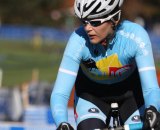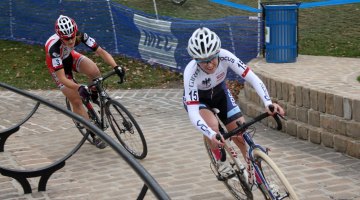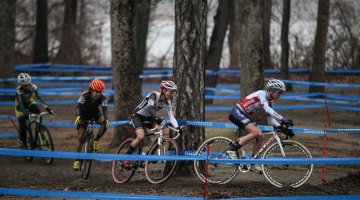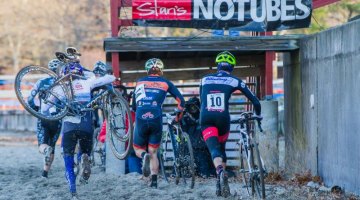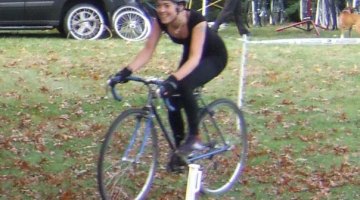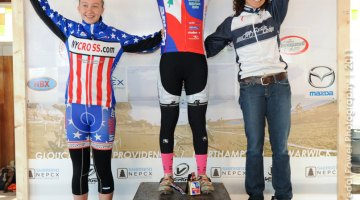Joy Stark is in her third year of racing cyclocross and rides for HUP United. Joy transitioned to bike racing after spending too many solitary mornings before dawn rowing single scull on the Charles River.
As part of her race prep, Joy often bakes Hupcakes for her teammates for NECX friends, which she has found to be more effective than standard openers. She works in marketing for a software firm and lives in Dorchester, Massachusetts.
In all three of the years that I’ve raced cyclocross, the Cycle-Smart International (CSI) race in Northampton has consistently emerged as a turning point in my season. By early November, I have enough races under my belt to identify mental patterns and skills that I need to improve on, and CSI offers the opportunity to commit to implementing changes.
CSI is incredibly well-organized and the course is set up nicely for spectating and socializing, making it one of my favorite races of the year. However, events in the weeks leading up to the race made me feel both mentally and physically unprepared for the effort of a Verge Series race. Instead of training, I spent several weeks in October celebrating my engagement to a racer I met during the ’cross season last fall, Kyle Smith. I also took some time off to prepare to race in the Head of the Charles Regatta, which I help organize.
I prepared to refocus on ’cross the week before CSI, but then disaster struck. On our way back from a wedding in upstate New York, my diesel engine car was contaminated by regular gas and required a tow. The car was loaded on the flat-bed tow truck with my and my fiancé’s bike still attached to the car’s roof rack. On the way to the car dealership, the tow truck hit a low power line. Our ’cross bikes were ripped from the roof rack and thrown into the street, gouging the frames, and destroying the forks, wheels, and many of the components. At first, I could see the humor in the absurdity of the circumstance, but as the week leading up to CSI progressed, laughter turned to tears as I made countless calls to mechanics, insurance companies, and bike shops to resolve the matter. I was in no mood to race.
Ever the optimist, Kyle convinced me that racing would be cathartic and good training for the races to come. Fortunately, Kyle and I ride the same frame size, and with the help of Andrea Smith at the Ride Studio Café, I was able to get a race machine rolling the day before the race. With only training goals in mind, we arrived at CSI on Saturday an hour before my race. I rode half a lap of the course, registered, and rode around to stay warm.
During staging, I was relieved to find that the early season Verge points I earned gave me a second row starting position. From experience, I knew that a good start would be critical to avoiding a pile-up at a formidable run-up in the early part of the course. I haven’t been starting well this season – it’s not unusual for me to have to dig myself out of 20 to 30 spots following the start. I was committed to working on this at CSI, however. When the whistle blew, I went for it – and stayed aggressive all of the way to the run-up. I had a clean dismount and clawed my way to the top among the fastest racers in my category.
When I reached the wooded section at the top of the course, I followed wheels and stayed focused on avoiding the slippery roots that seemed more pervasive this year. Going into the second lap, I realized that I was in a good position in the field and that I should focus on maintaining it for as long as possible. I felt surprisingly good for essentially four weeks off the bike. The anaerobic shock I anticipated never came, which helped me to stay relaxed and energized.
On the third lap of the race, I was recovering on the wheels of Natalia Boltukhova and Dana Prey – both aggressive, strong racers who I respect. I went into a curvy section of a dirt baseball diamond that had loosened up during our race a bit too hot, slid out, saved the slide, then promptly lost my wheel again and went down on my side hard.
For a second, I lay on the ground trying to catch the breath that was knocked from me. Pain seared my ribs, but my bike was fully functional, which meant that I had to finish the race. Over the next lap, I struggled to maintain my placing in the top 20, and eventually conceded a few spots. Still, I was pleased that my result didn’t suffer much from the time and energy I spent away from racing and riding.
I was determined to have a good race on Sunday after realizing that finishing in the top 20 was within my grasp. I took a pro tip from Kyle and lined up on the left side of the starting grid to take advantage of the wider line around the first corner. This move paid off well as I had a clear path to move up in the field while others got bogged down. I maintained my good position until a rider plowed into me with a good amount of momentum in the first stand pit. I bobbled and saw a dozen riders go by me. I spent the next lap struggling to get around people and ward off attacks from others. Instead of feeling fresh and relaxed as I had on Saturday, I felt sluggish and annoyed. The race couldn’t end soon enough.
In the final lap, I went through the barriers just ahead of one of my favorite nemesis, Sherri Curcuru. She made a joke to the crowd about me blocking her remount, and I laughed. I tried to stay ahead of Sherri through the remainder of the last lap, but she kicked it into high gear for our finishing sprint and beat me by a good margin.
The highs and lows of my weekend at CSI helped me to better understand how much racing depends on the mind’s willingness to find and exploit the dozens of positive moments that happen during our time on the course. With low expectations for Saturday’s race, I found it easy to block out the drama I had experienced in the week leading up to the race and maintain focus and confidence during the race. With a more vulnerable mindset on Sunday, I felt more easily defeated by each bobble and jostle. In the end, I found that my fiancé was right – racing really does fix everything, at least temporarily.













